
home I index I latest I glossary I introductions I e-mail I about this site
Rosary Cemetery Chapel, Norwich
Read
the captions by hovering over the images, and click on them to
see them enlarged.
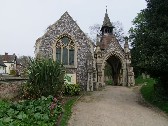
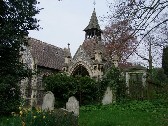
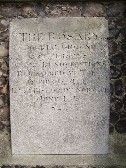
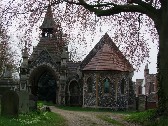
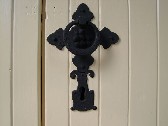
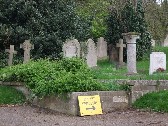
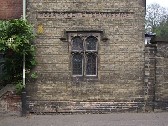
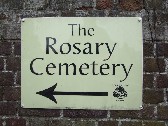
| Rosary
Cemetery Chapel, Norwich The cemetery sits on pleasingly rising land to the south-east of the city centre, as the hills climb away into Thorpe. In the 20th Century, it would be joined nearby by Norwich City's extraordinary former football ground, the Nest, which was almost adjacent - have two such unlikely neighbours ever existed in East Anglia? This part of Norwich became rapidly built up in the middle years of the 19th Century, mainly with the kind of middle-class villas still to be found on Thorpe Road and Riverside Road. Non-conformists tended to be poor in the early years of the Rosary, but it was in the second half of the 19th Century that the glory years of the cemetery began. In 1860, the strangely industrial-looking Gothic lodge at the entrance was built to the design of JS Benest, and then in 1879 it was joined by this fabulous little chapel, the finest work of Edward Boardman. It looks like something out of Le Grand Meaulnes; it is an impressively ornate French Gothic horror just ready for a coach and four to be driven under the porte-cochère in a wintery thunderstorm by a whip-cracking driver. But I like to explore the Roasary in late spring best. Its tight site, much smaller than similar cemeteries in other cities, means that the graves are squeezed into the rolling, climbing landscape, often in rows, and sometimes higgledy-piggledy. Thomas Drummond, the founder, is buried with his wife Ann not far to the south of the chapel. Their curious neo-classical memorial is hidden quietly beneath a tree. Ann was the first person to be interred in the cemetery, her body reburied here from Colegate Meeting House burial ground. Around them, and up the hill to the east, spread the thousands of others who have been laid to rest here in the years since. There are too many highlights to mention them all, and in any case you will want to explore this remarkable place for yourself, but there are ninety-odd images below of some of the memorials I like best. To mention some of the more significant, you won't in any case miss the large mausoleum to Emmanuel Cooper, just to the soth-east of the Drummon memorial. It was finished in his lifetime, and he often walked up here on a Sunday afternoon to sit in its entrance, smoking his pipe. Cameron Self of Literary Norfolk tells us that Cooper's daughter, the spendidly named Ada Nemesis Cooper, married the writer John Galsworthy. It is said that the family life of the Coopers inspired Galsworthy's most famous novel, The Forsyte Saga. By a pleasing act of symmetry, Galsworthy's biographer RH Mottram, the antiquarian and novelist who died in 1971, is buried under a far simpler and alarmingly leaning headstone a short way off. Mottram, a member of the congregation at the Octagon chapel as Thomas Drummond had been, was the last chair of the trustees of the Cemetery, before it was conveyed into the care of Norwich City Council just over half a century ago. The story since then seems to have largely been one of neglect, but there is a very active preservation group now working to restore the cemetery. Two rather
remarkable memorials stand not far from Boardman's
chapel. One is the vast cast iron tombchest to Jeremiah
Cozens, who died in 1849. His massive casket has a lion
with a ring in its mouth at each end in the best Grecian
fashion, and is signed by the Dixon Foundry, a reminder
that Norwich, like Ipswich, was an ironworking town.
Indeed, there are many more memorials here either made
from iron or having iron decorations. Even more striking
is the lifesize bust to John Barker, Steam Circus Proprietor, who was
accidentally killed on Norwich Cattle Market April 12
1897 aged 60 years: Beside the Barker memorial is one to Charles Thurston, Amusement Caterer. Barker had married into the Thurston family, and Thurston's fairs still tour England today. Another imposing sight is the plot dedicated to the famous Colman family, who were fire-breathing non-conformists. Curiously, their space is marked by two massive sentinels, one a column inscribed with some of that old misery St Paul's more doom-laden observations, and the other an elegant Saxon cross. On the ground around are stones bearing wholly secular memorial inscriptions. To the east are a number of simple headstones to those who worked on the railway at the bottom the hill. Inscriptions remember one who was for 36 years Inspector at Thorpe Station, while another was 34 years a guard on the GE Railway. Uncomfortably close to these is Joseph Hall Parnell, accidentally killed at Thorpe Station in 1882. Another stone has a now badly eroded image of a stream train in full flight. Slightly up the hill from here is Joseph Stringfellow, who sailed the river weaters clear - and, indeed, the gravestone has a carving of his little boat. More impressive is the stately galleon crossing the ocean on another headstone. Coming westward again, the artist Henry Housego is represented on his headstone by his palette and brushes. Sir George White, MP for Norwich in the late 19th Century, who laid the foundation stone of several of the city's Baptist churches, is familiar from the the inscriptions on them which can still be seen today. His last inscription is here. Another great Saxon cross nearby is to members of the Jarrold family. |
Simon Knott, June, updated August 2009
Amazon commission helps cover the running costs of this site.
home I index I latest I introductions I e-mail I about
this site I glossary
Norwich I ruined churches I desktop backgrounds I round tower churches
links I small
print I www.simonknott.co.uk I www.suffolkchurches.co.uk